Project Pinnamin Update - Gone rockhopping
09/12/2017 in RZSS
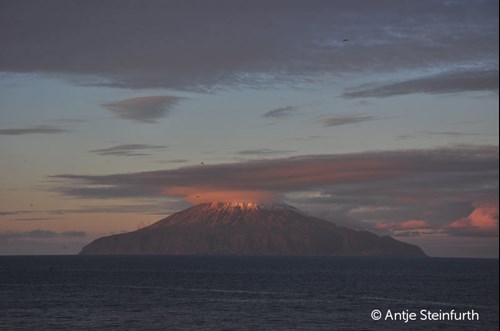
Above: The island of Tristan da Cunha
After seven days at sea and looking at shades of grey and blue, the sight of Tristan da Cunha stretching on the horizon, was a true feast for the eye. The island’s classic volcanic shape was seemingly rising straight from the ocean. As we approached the island, the morning light just highlighted the valleys and gullies on the volcano flanks and snow-capped St. Mary’s Peak sneaked though the clouds.
We had left Cape Town on the 7 September. For the fourth time I find myself onboard the South African research vessel SA Agulhas II on my way to Tristan da Cunha helping to protect one of the islands most iconic yet threatened species – the Northern rockhopper penguin.
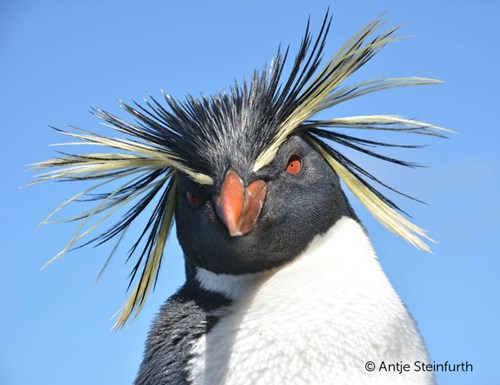
Above: A Northern rockhopper penguin
We arrived on Tristan da Cunha on 13 September. Nightingale Island, my final destination, was already visible through binoculars only about 28 km away, so near but still far. The next two days the crew was busy ferrying the passengers safely off to Tristan and offloading the cargo while I waited to reach my final destination – Nightingale Island. Thankfully I was in the best company. Two Tristanians, Simon Glass and Matthew Green, came onboard to join me on my trip to Nightingale. On 15 September we set sail once again and steamed across. With the lobster fishing boat the MFV Geo Searcher nearby, the water around the ship was now full of hopeful spectators. Giant Petrels, incessantly jeering and croaking, were bobbing expectantly on the water surface, waiting their chance to scavenge for scraps. Black-browed, sooty and yellow-nosed albatrosses, great shearwaters, broad-billed prions and smaller cape petrels were soaring the sky and amongst them the rare Tristan albatross, majestically flying by on broadsword wings. Occasionally rockhopper penguins popped up, looking simultaneously comical but furious due to the unruly tassels of yellow crest feathers above their eyes. It is difficult not to smile when looking at these most charismatic birds.
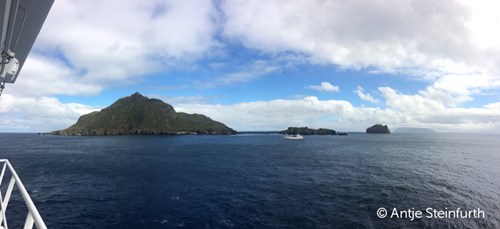
Above: Nightingale Island with Alex (Middle) and Stoltenhoff islands (from left to right)
While penguin colonies usually resemble a bustling hive of activity, upon our arrival, life in the penguin colony was actually very quiet. Most eggs had been laid, females were taking the first shift of incubating the eggs while males had left onto their foraging trips.
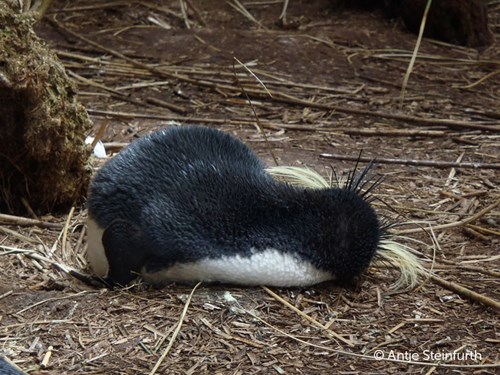
Above: Northern rockhopper penguin incubating eggs
Where the wild birds go
Determining where penguins go during their winter migration has proved to be a difficult task with the main obstacle being attaching devices with enough battery life and memory capacity that will last sufficiently long to cover the entire period of migration. Miniature GLS technology enables us to use the changing light intensities associated with sunrise and sunset, coupled with an accurate clock, to determine locations for up to three years.
Usage of these devices entails retrieving the devices in order to obtain the information and so the penguin has to be captured not only once, but twice. Crested penguins are known for a high nest-site and pair fidelity and therefore breeding birds have become the perfect target. In 2016 we equipped 20 males and 20 females with GLS devices in one of the smaller colonies, while individually marking our study birds with PIT (Passive integrated transponder) tags and nests with numbered pegs. The main task for this year’s field season was to retrieve the devices and by analysing these data to fill in an important knowledge gap by shedding some light (literally) on the penguin’s enigmatic life during winter. However, as so often, theory does not match practice and rest assured the penguins had us up for a good surprise: the whole colony was gone! We were lucky enough to discover that it hadn’t vanished but had (only) moved. While this of course was a relief, it did present a new challenge: Who is who in the new colony?
Who is who?
Truth be told, to the human eye, penguins do look quite alike. Fortunately however, “our” penguins were bar coded (PIT tagged) so that “a scan of every single bird was all we had to do” I thought naïvely. The true challenge on Nightingale Island however is summarized in four words: penguins breed in tussock.
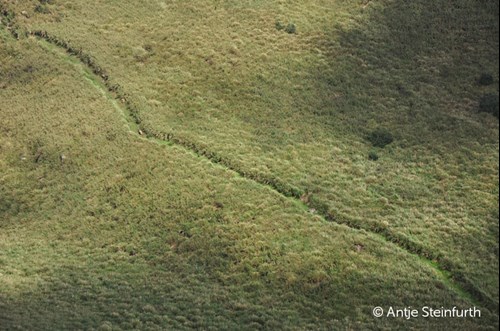
Above & below: Tussock Grass, Spartina arundinacea dominates most of Nightingale Island
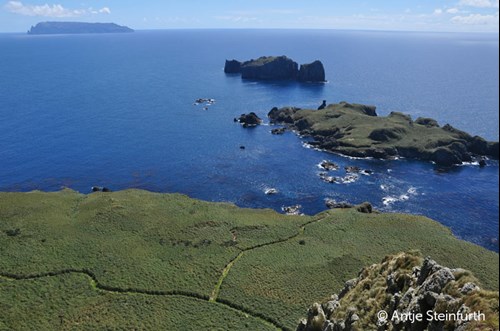
From the penguin’s point of view, being nestled into the depths of the high grass proves to be a wonderful protection not only against the elements but also against predation from the air. However it poses a logistical challenge for the field worker, who has to follow the penguins into their nesting grounds.
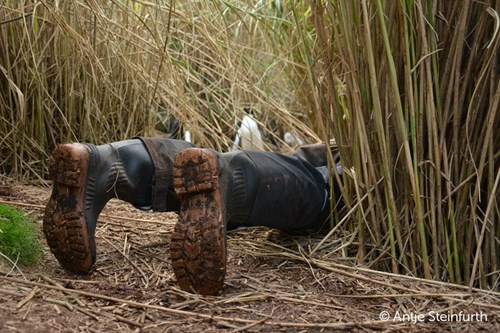
Above: Fieldworker crawling through the penguin colony
The new colony contains about 400 breeding pairs jam-packed onto an area around 300 m2. After scanning the colony not once but several times, we managed to find 13 out of 20 females. Our reader system later confirmed that four females had not returned to the island (yet) after winter migration and we knew males only returned from their (incubation) foraging trip shortly after my departure. But I was lucky enough to have colleagues working on the Wilkins’ Bunting staying on the Island who retrieved another 13 devices few weeks later. And the breeding season is not over yet!
Time was flying by far too quickly. After a week the weather was about to turn to the worst and far too quickly our pick up from Nightingale Island had to be arranged.
To wrap up the project I spent another two weeks on Tristan da Cunha to share my experience and knowledge with the local community, have meetings with the Island administration and conservation department and my personal highlight, to talk to the kids at school.
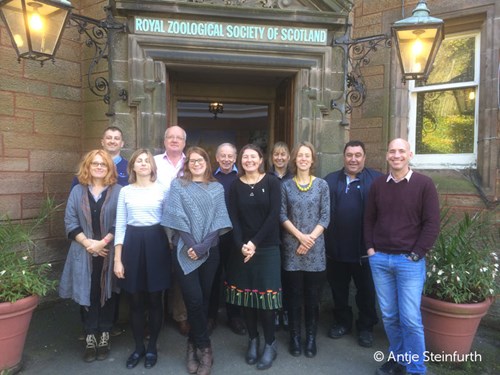
Above: Members of the team attending the Species Action Plan Workshop at RZSS Edinburgh Zoo
Soon it was time to say goodbye to the islands. On 4 October, together with Trevor Glass, the Head of the Tristan da Cunha Conservation Department, we boarded the SA Agulhas II. From Edinburgh of the Seven Seas we travelled to Edinburgh “of the North Sea” to attend the Species Action Plan Workshop for the Northern Rockhopper penguin, which was held at the Royal Zoological Society of Edinburgh end of October. The overarching objective for the workshop was to develop research and conservation actions for the Northern Rockhopper penguin to ensure populations in the Atlantic and Indian Ocean populations can thrive into the future.
Project Pinnamin is coming to an end in March 2018, after which the Tristanians will take over the project. We have learned so much in this time and I hope that the data we have gathered and the upcoming Species Action Plan, can help to make the difference for this unique species.
Thank you for sharing my adventure with me. If you would like to revisit earlier blogs in this series please click on the links below.
Antje
Dr Antje Steinfurth
> An introduction to Project Pinnamin
> Bizarre breeding behaviours of the Northern rockhopper penguin
Featured Articles

An update from the Budongo Forest
19/04/2024 in Conservation

Edinburgh Zoo named best zoo in Scotland
15/04/2024 in Edinburgh Zoo

























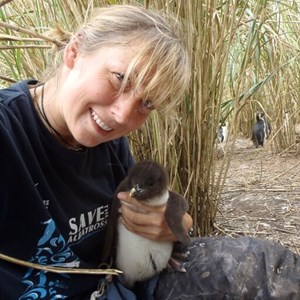
Follow EZ